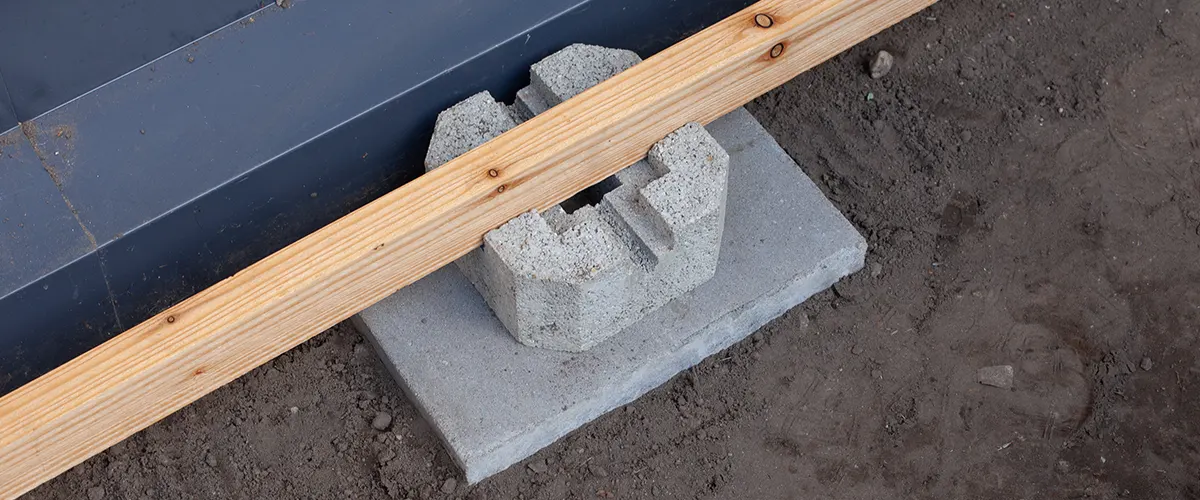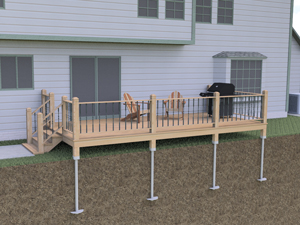Engineered for Success: The Scientific Research Behind Durable and Durable Deck Footings
Engineered for Success: The Scientific Research Behind Durable and Durable Deck Footings
Blog Article
Picking the Right Deck Footings for Security and Resilience
When it pertains to building a deck, one of one of the most critical decisions you will certainly make is selecting the best grounds for security and longevity. The longevity and security of your deck depend greatly on the kind of footings you select, as they give the crucial support and security to withstand the test of time. With a myriad of alternatives available, it can be overwhelming to identify which grounds are best matched for your certain requirements. In this conversation, we will discover the different kinds of deck footings, consider the vital elements to weigh when deciding, and explore the benefits and drawbacks of various choices. By the end, you will have a clearer understanding of the selections handy and be better outfitted to make a notified decision for your deck job.
Kinds Of Deck Grounds
These footings consist of a round opening filled up with concrete, which provides a solid structure for the deck messages. Concrete pier grounds are reasonably very easy to mount and offer superb security, making them a popular option for lots of deck projects.
These grounds are mounted by screwing them right into the ground, which produces a protected foundation for the deck. They also permit for very easy adjustment and progressing of the deck if required.
Additionally, some home builders choose precast concrete footings. These grounds are constructed from long lasting concrete and come in numerous forms and dimensions to suit different deck styles. Precast concrete grounds are practical to set up and offer a secure base for the deck structure.
Ultimately, one more option is the post-in-anchor ground system. This sort of ground involves driving a steel support into the ground and attaching it to the deck post. It uses flexibility in terms of positioning the deck messages and is appropriate for decks with lightweight structures.
When selecting the appropriate sort of deck footing, it is necessary to take into consideration aspects such as soil conditions, deck tons, and local building regulations (Deck Footings). Consulting with a professional specialist or structural engineer can help make certain the suitable ground is chosen for a stable and safe deck
Aspects to Take Into Consideration When Selecting Footings
When picking the ideal footings for a deck, it is vital to thoroughly take into consideration numerous variables such as dirt conditions, deck tons, and adherence to regional structure codes. These factors play a considerable role in making sure the security and resilience of the deck framework.
The type of dirt on which the deck will certainly be built establishes the kind of footings required. On the other hand, decks constructed on clay or expansive soils may need grounds that can accommodate the dirt's tendency to increase and agreement.
One more important factor is the deck tons. The weight of the deck, including the products used and any possible live lots such as furniture or gatherings, must be taken right into account when selecting grounds. The footings have to be designed to birth the weight of the deck and disperse it uniformly to stop any kind of architectural problems or failings.
Last but not least, adherence to neighborhood building regulations is extremely important. Building regulations vary from area to region, and it is necessary to follow the particular requirements set by the neighborhood click reference authorities. Deck Footings. These codes make sure that the deck is constructed securely and fulfills the necessary standards for architectural integrity and load-bearing capacity
Concrete Grounds: Advantages And Disadvantages

When used as the foundation for a deck,Concrete footings supply several advantages and negative aspects. On the silver lining, concrete grounds give exceptional stability and longevity. Concrete is a rigid and strong product that can sustain hefty loads and hold up against different weather. It likewise has a lengthy life expectancy, making it a trustworthy selection for lasting use.
An additional benefit of concrete grounds is their adaptability. They can be put into different sizes and shapes to fit various deck designs and configurations. Concrete footings can be tailored to fit the details needs and requirements of the deck structure.
However, there are additionally some disadvantages to using concrete footings. This can raise the general price of the deck project and might call for professional support.

Helical Piers Vs. Sonotubes: Which Is Much better?
In thinking about the structure alternatives for a deck, the comparison in between helical piers and sonotubes is critical in identifying the superior choice. Helical piers, likewise known as screw heaps, are steel shafts with helical plates affixed to them. They are twisted into the ground using hydraulic machinery, supplying a secure and sturdy foundation for the deck. On the other hand, sonotubes are cylindrical forms constructed from cardboard or fiber product that are loaded company website with concrete. They are placed in a hole explored the ground and give assistance for the deck.
When it concerns security and durability, helical piers have the upper hand. The helical plates on the piers create a strong grip with the dirt, preventing any motion or moving of the deck. This is particularly useful in areas with unpredictable or moving dirt conditions. Sonotubes, on the other hand, rely entirely on the concrete filling up for security, which may not supply the same level of strength and resistance.
In regards to setup, helical Discover More piers are fairly easier and faster to install contrasted to sonotubes. The hydraulic machinery made use of to twist the piers right into the ground makes sure a quick and efficient process. Sonotubes, on the other hand, call for digging holes and pouring concrete, which can be taxing and labor-intensive.
Additionally, helical piers are an even more versatile option. They can be utilized in different soil problems and can be changed or enhanced if required. Sonotubes, on the various other hand, may require added assistance, such as rebar, in particular dirt conditions or locations with high lots demands.
Selecting the Right Footings for Your Deck's Measurements
For ideal structural integrity, it is important to carefully pick the appropriate grounds that line up with the dimensions of your deck. The measurements of your deck, including its elevation, size, and width, play a significant role in identifying the type and dimension of grounds called for.
When selecting footings for your deck, it is essential to consider the load-bearing capacity of the soil. The weight of the deck, integrated with the weight of any furniture or people on it, exerts a considerable pressure on the footings (Deck Footings). As a result, it is vital to pick footings that can effectively sustain this weight without sinking or shifting gradually.
The shapes and size of the footings must also be considered. Larger decks with greater measurements call for larger footings to provide sufficient security and assistance. The shape of the grounds, whether they are square or round, depends on the layout and design of the deck. Furthermore, the deepness at which the footings are mounted need to be identified based on the frost line in your region to stop any heaving or moving as a result of freezing temperature levels.
Conclusion
In verdict, selecting the appropriate deck footings is vital for making certain stability and toughness. Aspects such as the kind of footings, the deck's dimensions, and the pros and disadvantages of various choices should be thought about.
These footings consist of a round opening filled up with concrete, which gives a strong foundation for the deck blog posts. Concrete pier grounds are relatively easy to set up and offer superb security, making them a preferred selection for many deck tasks.
Precast concrete grounds are hassle-free to mount and provide a secure base for the deck structure.
It offers versatility in terms of positioning the deck articles and is appropriate for decks with light-weight structures.
Concrete grounds use several benefits and drawbacks when used as the foundation for a deck.
Report this page